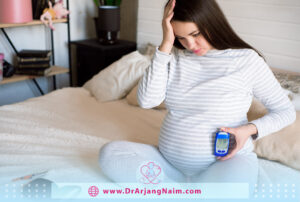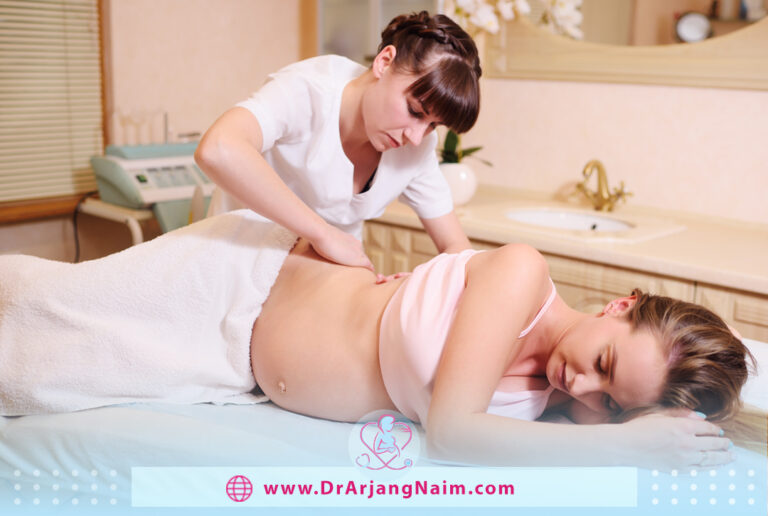Massage therapy has been used for centuries to improve overall health, reduce stress, and reduce muscle tension. Research shows that prenatal massage therapy can help reduce anxiety, reduce symptoms of depression, relieve muscle and joint pain, and improve birth outcomes and baby health.
Prenatal massage
Prenatal massage is a specialized form of massage therapy tailored for pregnant women, conducted by certified therapists well-versed in the unique needs and safety considerations during pregnancy. It aims to alleviate pregnancy-related discomforts, such as back pain and swelling, while promoting relaxation and stress reduction. The techniques are modified to suit the pregnant body, focusing on gentle strokes and positions that ensure the mother’s and baby’s safety and comfort. It’s generally safe across all pregnancy trimesters, with appropriate adjustments in technique and pressure. Effective communication between the client and therapist is essential to tailor the massage to the client’s specific needs and provide a positive experience.

When to get a prenatal massage
Prenatal massages can generally be received at any point during pregnancy, but some considerations are based on the trimesters.
First trimester
Prenatal massages during the first trimester are generally safe, but many women prefer to wait until they are past the early stages of pregnancy when morning sickness and sensitivity to touch may be more pronounced.
Second trimester
The second trimester is often considered an ideal time for prenatal massages. Morning sickness has usually subsided, and the discomforts of later pregnancy have yet to set in significantly.
Third trimester
Prenatal massages are still safe and beneficial during the third trimester. However, positioning during the massage becomes increasingly essential to accommodate the growing belly and ensure the mother’s comfort.
It’s essential to consult with your healthcare provider before scheduling a prenatal massage, especially if you have specific health concerns or complications during your pregnancy. They can guide the timing and any precautions you should take. Additionally, always choose a certified prenatal massage therapist experienced in working with pregnant clients.
Benefits of prenatal massage
Prenatal massage offers various benefits to pregnant women, addressing both physical and emotional well-being during pregnancy.
Stress and anxiety reduction
Prenatal massage promotes relaxation and reduces stress by releasing endorphins, the body’s natural feel-good hormones. It can provide a calming effect during significant change and anticipation.
Pain relief
It helps alleviate common pregnancy discomforts such as lower back pain, neck and shoulder tension, leg cramps, headaches, and joint pain by relieving muscle tension and improving circulation.
Improved circulation and edema reduction
Massage techniques enhance blood circulation and lymphatic flow, reducing swelling (edema) in the extremities often experienced during pregnancy.
Better sleep quality
Prenatal massage can improve sleep patterns and quality, helping pregnant women get more restful and rejuvenating sleep.
Muscle relaxation and flexibility
The gentle massage strokes help relax muscle tension and improve flexibility, improving overall comfort and mobility during pregnancy.
Emotional support and well-being
Touch therapy in prenatal massage can provide emotional support and nurturing, promoting a sense of well-being and reducing symptoms of anxiety and depression.
Hormonal regulation
Massage can help regulate hormones such as cortisol and norepinephrine, aiding mood stabilization and reducing stress levels.
Preparation for labor and birth
Prenatal massage may assist in preparing the body for labor by helping to relax and loosen muscles, potentially facilitating a smoother labor and delivery process.
Bonding time
For expectant mothers, prenatal massage can offer a dedicated time to connect with their changing bodies and the growing life inside them, fostering a deeper bond.
It’s essential to consult with a healthcare professional before starting any new wellness routine, including prenatal massage, especially during pregnancy. Choose a certified prenatal massage therapist to ensure a safe and beneficial experience.

Prenatal massage risks
Prenatal massage is generally safe and beneficial for most pregnant women, but there are some considerations and potential risks to be aware of.
Risk of premature labor
If pressure points are manipulated incorrectly during the massage, there may be a risk of stimulating uterine contractions, potentially leading to premature labor. It’s crucial to ensure the massage therapist is well-trained in prenatal massage techniques to avoid this risk.
Deep tissue massage caution
Deep tissue massage techniques should be avoided during pregnancy, especially on the legs and lower back, as they could potentially dislodge blood clots.
Certain medical conditions
Women with certain medical conditions (e.g., preeclampsia, blood clots, clotting disorders, deep vein thrombosis, high blood pressure, and placental abnormalities) should consult their healthcare provider before getting a prenatal massage to ensure it is safe.
High-risk pregnancy
If a pregnancy is classified as high-risk due to medical complications, seeking guidance from a healthcare professional before receiving a prenatal massage is essential.
Allergic reactions to massage oils/lotions
Some individuals may have allergies or sensitivities to massage oils, lotions, or aromatherapy products used during the massage. Ensure that the products being used are safe and suitable for pregnant women.
Nausea and discomfort
In some cases, the positioning during the massage can cause discomfort or nausea, especially if the pregnant woman is in a face-down position for an extended period. Therapists should use appropriate positions to ensure comfort and safety.
Inexperienced massage therapist
Choosing an inexperienced or untrained massage therapist for prenatal massage increases the risk of improper techniques that could cause discomfort or potential harm to the mother or baby.
Where not to massage a pregnant woman
Specific areas on a pregnant woman’s body should be avoided or treated with caution due to potential risks or discomfort when providing a prenatal massage. Here are the key areas where massage should be approached carefully or avoided:
Abdomen
Direct pressure on the abdomen should be avoided, especially in the later stages of pregnancy, to prevent potential harm to the developing fetus.
Certain pressure points
Avoid deep pressure on specific pressure points associated with inducing labor, as it could stimulate uterine contractions and lead to premature labor.
Inner ankles and wrists
Pressure points on the inner ankles and wrists should be avoided, as they are associated with inducing labor and may be too sensitive during pregnancy.
Sacrum and tailbone area
The sacrum and tailbone area should be treated gently and avoided if the client experiences discomfort or has a history of spinal issues.
Legs, ankles, and feet
While massaging the legs, ankles, and feet is generally beneficial, deep tissue massage in these areas should be administered with caution, especially if the client has a history of blood clots or circulation issues.
Back of knees
Be cautious when massaging the back of the knees, as this area can be sensitive and uncomfortable for some pregnant women.
Deep tissue techniques in the lower back
Avoid deep tissue massage techniques on the lower back, especially around the sacral area, to prevent potential discomfort or harm.
It’s crucial for the massage therapist to communicate with the pregnant client, listen to their feedback, and adjust the massage techniques and pressure accordingly. Safety and the well-being of the mother and the baby should always be the top priority during a prenatal massage.

Tips for massage during pregnancy
Once your doctor has approved and you’ve found a qualified therapist, there are a few steps you can take to ensure you have a positive prenatal massage experience. These tips include:
- Try to leave your self-consciousness at the door: If you’re feeling uneasy about your pregnancy body, try getting a massage with the confidence that the therapists are unbiased and will help you feel your best.
- Speak up: Let your therapist know if you are uncomfortable exposing certain body parts. A professional massage therapist creates a safe environment for the massage and does not force you to do anything that makes you uncomfortable.
- Drink plenty of water before and after your massage: Drink plenty of water before and after the massage. Staying hydrated is always essential; fluids help flush out toxins.
- Avoid scheduling your appointments more often than weekly: The general recommendation is to have prenatal massages no more than once a week, but you should ask your doctor how often is right for you.
The bottom line
Pregnancy massage is a type of massage therapy specifically designed for pregnant women during pregnancy, also called prenatal massage. This massage may help relieve some pains and contractions during pregnancy. However, its dangers cannot be ignored.
Prenatal massage can be a way to relax your body and mind during pregnancy, but you should check with your doctor before scheduling a session. There are conditions and situations that make massage during pregnancy unsafe.
Once you have your doctor’s approval, look for a massage therapist trained and certified in prenatal massage.
Additional questions
- What are the ways to reduce stress in pregnant women?
- Practice mindfulness
- Try complementary therapies
- Talk about your mental health
- Eat well
- Get more exercise
- Learn what to expect during labor
- Reduce your stress levels on your daily commute
- Get enough rest and sleep
- Take a deep breath and focus on your baby
- What are the benefits of endorphins in pregnancy?
Endorphins, natural hormones produced by the body, offer multiple benefits during pregnancy. They act as natural painkillers, providing relief during labor and delivery, reducing stress, enhancing mood, and promoting better sleep. Endorphins play a vital role in aiding the birthing process and fostering a strong bond between the mother and the baby. Additionally, they assist in appetite regulation, boost the immune system, and contribute to an overall sense of well-being during this crucial period of a woman’s life.
- What hormones are stimulated by massage?
An increase in endorphins, serotonin, and dopamine hormones is a common benefit achieved through massage. Endorphins, serotonin, and dopamine are positive hormones circulating throughout the body, making a person happy, and reducing anxiety.
- What oils are best for massage?
When choosing a massage oil, consider your skin type and massage goals. Sweet almond oil is light and hydrating, suitable for most skin types, while coconut oil is nourishing and great for dry or sensitive skin. Jojoba oil resembles natural skin oils, making it easily absorbed and ideal for all skin types. Grapeseed oil is lightweight and antioxidant-rich. Avocado oil is thick and moisturizing, perfect for dry or mature skin. Sunflower oil is lightweight and vitamin-rich, and argan oil is nourishing for dry or aging skin.
- What are the five placental abnormalities?
These placental disorders are called placenta previa, placenta accreta, placenta increta, or placenta percreta. Placental disorders are usually diagnosed by ultrasound in the second trimester of pregnancy. Placenta previa occurs when the placenta covers part or all of the cervix.
References
https://americanpregnancy.org/healthy-pregnancy/is-it-safe/prenatal-massage/
https://www.whattoexpect.com/pregnancy/pregnancy-health/prenatal-massage/
https://www.thebump.com/a/prenatal-massage-safety
https://www.alicepeckday.org/what-is-prenatal%20massage
https://www.verywellhealth.com/pregnancy-massage-benefits-contraindications-and-safety-5190485
https://pressmodernmassage.com/blogs/going-deep/how-is-prenatal-massage-different
https://health.clevelandclinic.org/prenatal-massage/




